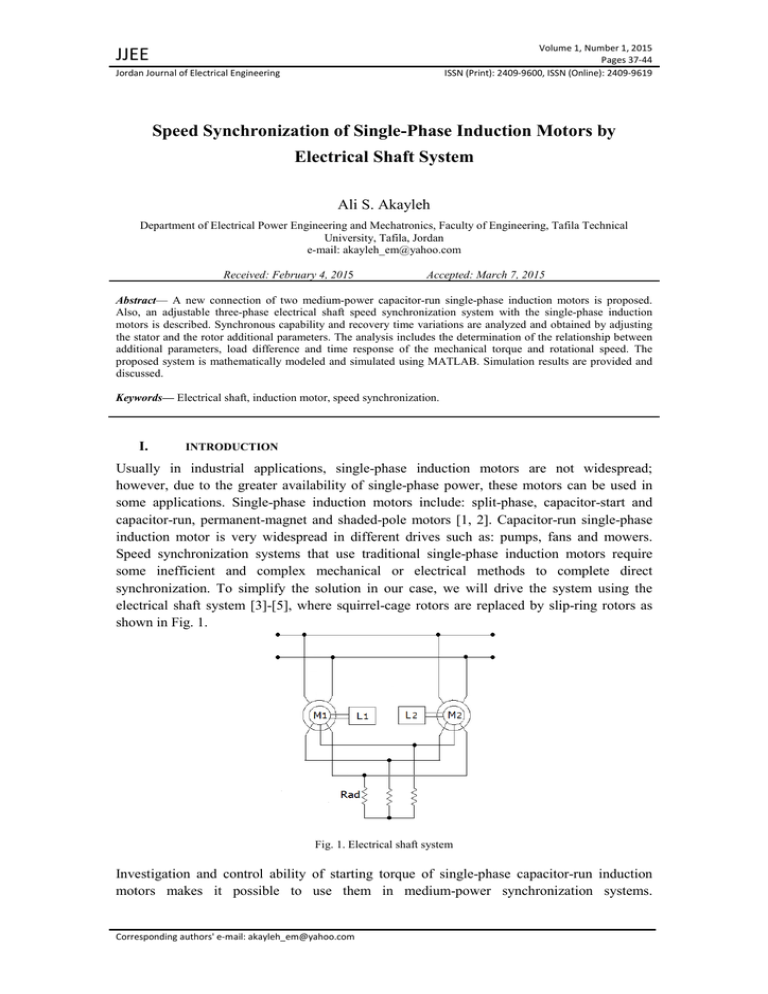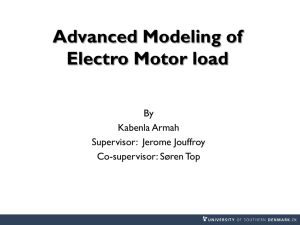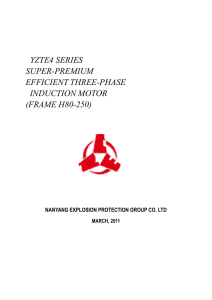
Volume 1, Number 1, 2015
Pages 37-44
ISSN (Print): 2409-9600, ISSN (Online): 2409-9619
JJEE
Jordan Journal of Electrical Engineering
Speed Synchronization of Single-Phase Induction Motors by
Electrical Shaft System
Ali S. Akayleh
Department of Electrical Power Engineering and Mechatronics, Faculty of Engineering, Tafila Technical
University, Tafila, Jordan
e-mail: akayleh_em@yahoo.com
Received: February 4, 2015
Accepted: March 7, 2015
Abstract— A new connection of two medium-power capacitor-run single-phase induction motors is proposed.
Also, an adjustable three-phase electrical shaft speed synchronization system with the single-phase induction
motors is described. Synchronous capability and recovery time variations are analyzed and obtained by adjusting
the stator and the rotor additional parameters. The analysis includes the determination of the relationship between
additional parameters, load difference and time response of the mechanical torque and rotational speed. The
proposed system is mathematically modeled and simulated using MATLAB. Simulation results are provided and
discussed.
Keywords— Electrical shaft, induction motor, speed synchronization.
I.
INTRODUCTION
Usually in industrial applications, single-phase induction motors are not widespread;
however, due to the greater availability of single-phase power, these motors can be used in
some applications. Single-phase induction motors include: split-phase, capacitor-start and
capacitor-run, permanent-magnet and shaded-pole motors [1, 2]. Capacitor-run single-phase
induction motor is very widespread in different drives such as: pumps, fans and mowers.
Speed synchronization systems that use traditional single-phase induction motors require
some inefficient and complex mechanical or electrical methods to complete direct
synchronization. To simplify the solution in our case, we will drive the system using the
electrical shaft system [3]-[5], where squirrel-cage rotors are replaced by slip-ring rotors as
shown in Fig. 1.
Fig. 1. Electrical shaft system
Investigation and control ability of starting torque of single-phase capacitor-run induction
motors makes it possible to use them in medium-power synchronization systems.
Corresponding authors' e-mail: akayleh_em@yahoo.com
38
© 2015 Jordan Journal of Electrical Engineering. All rights reserved - Volume 1, Number 1
Electromagnetic torque and rotational speed in both motors can be controlled by adjusting the
additional resistance and capacitor. In this paper, we describe adjustable speed
synchronization between two identical capacitor-run single-phase induction motors based on
the electrical shaft system, where rotor circuits are connected together to the common
additional resistor. The additional resistor in the rotor common circuit plays the most
important role in the determination of the synchronous capability and recovery time of the
system. The additional capacitor in the stator circuit plays the main role in adjusting and
controlling the electromagnetic torque [6]-[8]. The system was designed, modeled and tested
with various loads and additional parameters.
II.
EQUIVALENT CIRCUIT OF THE SYSTEM
In order to derive the equivalent circuit, a machine consisting of forward and backward
sequence circuits is considered [2]-[9]. Under this condition, equivalent circuits can be
presented as shown in Fig. 2.
a
b
Fig. 2. Forward (a) and backward (b) sequence equivalent circuits
Where the forward and backward impedances of the rotor circuit (ZF and ZB) are calculated as
follows:
ZF
R 2′ X µ ( X 2 + X µ ) R 2′ X 2 X µ
−
S
S
1
=
2
2
R 2′
2
+ (X 2 + X µ′ )
S
R 2′ X µ ( X 2 + X µ R 2′ X 2 X µ
−
(2 − S )
1
(2 − S )
ZB =
2
2
R 2′
+ (X 2 + X µ′ )2
2−S
+
+
R 2′ 2 X µ
+ (R 2′ X 2 ( X 2 + X µ ) )
S2
J
2
R 2′
2
+ (X 2 + X µ′ )
S
R ′2 X
2 µ + (R ′ X ( X 2 + X ) )
µ
2
2
(2 − S ) 2
J
2
R 2′
+ (X 2 + X µ′ )2
2−S
© 2015 Jordan Journal of Electrical Engineering. All rights reserved - Volume 1, Number 1
39
where R1, X1 are the stator resistance and inductive reactance; R2, X2 are the rotor resistance
and inductive reactance; EF2(1), EF2(2) are the forward induced voltages in the rotors; EB2(1),
EB2(2) are the backward induced voltages in the rotors; IF2(1), IF2(2) are the forward currents in
the rotors; IB2(1), IB2(2) are the backward currents in the rotors; Xµ is the inductive reactance of
the magnetization circuit; XC is the capacitive reactance, and S is the slip of the motor.
Difference in motors' speeds causes difference in phase angles between the stator and rotor
windings (α1, α2). Therefore, it is possible to represent the difference in loads by the
differences in phase angles. At equal loads, phase angles will be equal too (α1=α2), and ∆α=0
[10, 11]. Using the equivalent circuit of Fig. 2, the rotor balance voltage can be calculated as
follows:
E F′ 2 (1) = I F′ 2 (1) [(R1 + R F ) + j ( X 1 + X F − X C )] + I F′ 2 ( 2 ) [R ad / S ]
1
E F′ 2 ( 2 ) = I F′ 2 ( 2 ) [(R1 + R F ) + j ( X 1 + X F − X C )] + I F′ 2 (1) [R ad / S ]
2
E B′ 2 (1) = I B′ 2 (1) [(R1 + R B ) + j ( X 1 + X B − X C )] + I B′ 2 ( 2 ) [Rad /( 2 − S )]
3
E B′ 2 ( 2 ) = I B′ 2 ( 2 ) [(R1 + R B ) + j ( X 1 + X B − X C )] + I B′ 2 (1) [Rad /( 2 − S ) ]
4
From (1)-(4), the rotor current will be:
I F′ 2( 1 ) =
′ + EF2(2)
′
′ − EF2(2)
′
EF2(1)
EF2(1)
1
+
(
2 R1 + RF ) + j ( X 1 + X F − X C ) + 2 Rad / S R1 + R F + j ( X 1 + X F − X C )
I F′ 2( 2 ) =
′ + EF2(2)
′
′ − EF2(1)
′
EF2(1)
EF2(2)
1
+
(6)
2 (R1 + RF ) + j ( X 1 + X F − X C ) + 2 Rad / S R1 + R F + j ( X 1 + X F − X C )
(
)
(
(5)
)
I B′ 2( 1 ) =
′ + EB2(2)
′
′ − EB2(2)
′
EB2(1)
EB2(1)
1
+
(7)
2 (R1 + RB ) + j ( X 1 + X B − X C ) + 2 Rad /( 2 − S ) (R1 + RB ) + j ( X 1 + X B − X C )
I B′ 2( 2 ) =
′ + EB2(2)
′
′ − E B2(1)
′
EB2(1)
EB2(2)
1
+
(8)
2 (R1 + RB ) + j ( X 1 + X B − X C ) + 2 Rad /( 2 − S ) (R1 + RB ) + j ( X 1 + X B − X C )
If the first motor is considered as a reference motor of the system, then E F′ 2 (1) = E 2′ ,
EF′ 2( 2) = E2′ e j∆α , S = S1 and ∆α =α1 −α2 . If the second motor is considered as a reference
j ∆α
motor of the system, then E F′ 2 ( 2 ) = E 2′ , E F′ 2 (1) = E 2′ e , S = S 2 and ∆α = α 2 − α1 ; and
consequently, the second motor torque can be determined in a similar way to the first motor.
Since the calculations of the first and the second motors are identical, then it is enough to
perform calculations and investigations for the first motor only. The torque of the first motor
may be calculated by the following formula [2], [12, 13]:
40
© 2015 Jordan Journal of Electrical Engineering. All rights reserved - Volume 1, Number 1
TF (1) =
E 2′
I F′ 2 (1) + I&F′ 2 (1)
2ωo
]
(9)
TB (1) =
E 2′
I B′ 2 (1) + I&B′ 2 (1)
2ωo
]
(10)
2
2
[
[
where ωo is the no-load rotational speed in rad/s.
Having added the value of the rotor current ( I F′ 2 (1) ) and its conjugate ( I&F′ 2 (1) ) and performed
some mathematical manipulations, the torque represented by (9) and (10) becomes:
TF (1)
R
R1 + RF + ad (1 + cos ∆α )
(R1 + RF )(1 − cos ∆α ) +
S
+
2
2
2
(R + R ) + ( X + X − X )
R
2
1
F
1
F
C
ad
R1 + RF +
+ ( X 1 + X F − X C )
2
S
E2′
=
(11)
2ωo
(
X 1 + X F − X C )sin ∆α
(
X 1 + X F − X C )sin ∆α
−
2
(R1 + RF )2 + ( X 1 + X F − X C )2
Rad
2
R1 + RF + S + ( X 1 + X F − X C )
TB(1)
R
R1 + RB + ad (1 + cos ∆α )
(R1 + RB )(1 − cos ∆α ) +
2−S
+
2
(R + R )2 + ( X + X − X )2
R
2
1
B
1
B
C
R1 + RB + ad + ( X 1 + X B − X C )
2
2−S
E2′
=
(12)
2ωo
(
(
X 1 + X F − X C )sin ∆α
X 1 + X F − X C )sin ∆α
−
2
(R1 + RB )2 + ( X 1 + X B − X C )2
Rad
2
R1 + RB + 2 − S + ( X 1 + X B − X C )
The total torque of the first motor becomes:
T(1) = TF (1) − TB (1)
III.
(13)
MODELING AND TESTING
The mathematical model of the system has been built as a subsystem block of the main
equivalent circuit, dynamic torque, angular speed, and angular position equations as shown in
Fig. 3. This model consists of two blocks. Each of them has a specific function. Simulation
and modeling characteristics of single-phase machine using MATLAB applications are
increasingly implemented [15]-[17]. The investigation and control of the system use two
identical single-phase induction motors with the following parameters: 0.25-hp, 50-Hz, 4Pole, Vph=220V, Io=3.56A, Xµ=66.89Ω, R1=2.02Ω, R2=4.12Ω, X1=2.793Ω and X2=4.12Ω.
© 2015 Jordan Journal of Electrical Engineering. All rights reserved - Volume 1, Number 1
41
Fig. 3. Mathematical model of the study system
Speed, pu
The main effect of additional parameters (Xc, Rad) on the system behavior can be found using
the factor K=Xc/Rad. Fig. 4 shows the speed response, in per unit, at various loads. It shows
that increasing the load difference decreases the synchronous capability of the system.
Consequently, the motors operate as individual induction motors.
Time, s
Fig. 4. Speed response at K=5 and L1=(1, 1.2 and 1.6)L2
The effect of factor K on starting torques and speed response at L1=1.6L2 can be found in Figs.
5 and 6. Fig. 5 shows that increasing factor K increases the starting torque value especially at
the first moment of starting.
© 2015 Jordan Journal of Electrical Engineering. All rights reserved - Volume 1, Number 1
Torque, Nm
42
Time, s
Fig. 5. Torque response at L1=1.6L2, and K=5, 10 and 25
Speed, pu
Fig. 6 shows that increasing factor K leads to increase the synchronous capability and
decrease the recovery time of the system; and consequently, it leads to an increase in system
performance specifications.
Time, s
Fig. 6. Speed response at L1=1.6L2, and K=5, 10 and 25
© 2015 Jordan Journal of Electrical Engineering. All rights reserved - Volume 1, Number 1
IV.
43
CONCLUSIONS
Speed synchronization of multiple induction motors can work with capacitor-run single-phase
induction motor based on simplified circuit electrical shaft system. By selecting the stator and
rotor's additional parameters (adjusting the K factor value), we can find the maximum limit of
the synchronous capability and recovery time of the system. The main disadvantage of the
system is the reduction of system efficiency which is associated with the slip ring rotor and
backward torque. Increasing factor K leads to improved system performance and reduction of
this drawback. Practically, performance specifications of the synchronization system that uses
single-phase induction motors do not coincide with modulation results due to the following:
1) Calculations were made with some simplification, such as linearization of the
magnetic circuit.
2) The actual speed of synchronization systems will be done through a particular
transmission, where the actual speed will be reduced to a tenth of the corrected or
controlled speed.
REFERENCES
[1] I. Boldea and S. A. Nasar, The Induction Machine Handbook, CRC Press, 2001.
[2] S. J. Chapman, Electric Machinery Fundamentals, McGraw-Hill, 2004.
[3] A. S. Akayleh, "Mathematical model of resistor effect on the synchronization systems," Far East
Journal of Dynamical Systems, vol. 12, no. 1, pp. 41-53, 2010.
[4] A. S. Akayleh, A. Samarai, and M. Al-Soud, "Mathematical model of inductive effect on the multimotors synchronization systems," Jordan Journal of Mechanical and Industrial Engineering, vol.
3, no. 2, pp. 151-156, 2009.
[5] A. S. Akayleh, "Mathematical model of capacitor effect on the synchronization systems," European
Journal of Scientific Research, vol. 32, no. 1, pp. 34-42, 2009.
[6] A. Leicht and K. Makowski, "Analysis of a single-phase capacitor induction motor operating at two
power line frequencies," Archives of Electrical Engineering, vol. 61, no. 2, pp. 251-266, 2012.
[7] R. Thinga, S. Gupta, and S. P. Phulambikar, "Field oriented control of single-phase induction
motor," International Journal of Emerging Technology and Advanced Engineering, vol. 4, no. 8,
pp. 760-763, 2014.
[8] E. S. Oluwasogo and I. K. Okakwu, "Performance Analysis of a single-phase AC voltage controller
under induction motor load," International Journal of Research in Engineering and Technology,
vol. 3, no. 6, pp. 184-191, 2014.
[9] Z. Zhang, K. T. Chau, and Z. Wang, "Chaotic speed synchronization control of multiple induction
motors using stator flux regulation," IEEE Trans. on Magnetics, vol. 48, no. 11, pp. 4487 – 4490,
2012.
[10] A. S. Akayleh, "Mutual inductance effect on the speed control of synchronization systems,"
International Journal of Simulation Systems, vol. 10, no. 2, pp. 37-42, 2009.
[11] A. S. Akayleh and S. M. Abdallah, "The systems of Synchronous rotation in the base of
electromagnetic working shaft with insertion capacitances in the rotor coils," Jordan Journal of
Applied Science, vol. 7, no. 1, pp. 24-33, 2005.
[12] A. S. Akayleh, "Synchronization of induction motors rotation in the multi-motor drive systems,"
International Carpathian Control Conference, ICCC’2004, pp. 9-14, 2004.
44
© 2015 Jordan Journal of Electrical Engineering. All rights reserved - Volume 1, Number 1
[13] K. C. Agrawal, "Starting and Control of Slip-Ring Induction Motors," in Industrial Power
Engineering and Applications Handbook, Butterworth-Heinemann, pp. 81-96, 2001.
[14] Y. Pannatier and B. Kawkabani, "Start-up and synchronization of a variable speed pump-turbine
unit in pumping mode," XIX International Conference on Electrical Machines, ICEM, 2010.
[15] S. Sarkar, S. Paul, S. Samaddar, S. Sarkar, P. K. Saha, and G. K. Panda, "Modelling, analysis and
simulation of split phase type single phase induction motor," International Journal of Advanced
Research in Electrical, Electronics and Instrumentation Engineering, vol. 2, no. 5, pp. 1683-1690,
2013.
[16] D. Zhao, C. Li, and J. Ren, "Speed synchronization of multiple induction motors with adjacent
cross coupling control," 28th Chinese Control Conference Shanghai, pp. 6805-6810, 2009.
[17] S. Ayasun and O. Nwankpa, "Induction motor tests using MATLAB/Simulink and their
integration into undergraduate electric machinery courses," IEEE Trans. on Education, vol. 48,
no. 1, pp. 37-46, 2005.



